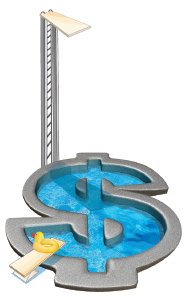
Explore This Issue
ACEP Now: Vol 35 – No 10 – October 2016ILLUSTRATION: PAUL JUESTRICH, PHOTOS: shutterstock.com
Q. I don’t like watching the value of my investments going up and down—it feels like I’m in a casino sometimes. How much risk should I be taking with my portfolio?
A. The more investors learn about investing, the more they realize it’s all about risk management—and the risks you face matter far more than the past or projected returns of the investment. In the words of Will Rogers, “I am not so much concerned with the return on my capital as I am with the return of my capital.”
However, it’s also important to not take on too little investment risk, as one of the most significant risks an investor faces is shortfall, or running out of money in retirement. The lower returns available on lower-risk investments may not allow your money to grow fast enough for your needs. There’s a reasonable range of risk for an investor to appropriately take, but there are far too many investors whose portfolios fall outside of that range.
RISK VERSUS REWARD
The amount of risk you take should be directly related to your need and ability to take risk. Most investors have a significant need to take on risk, but there are some who do not. For example, an investor with a $10 million portfolio who needs only $100,000 a year from it can eliminate almost all significant risk from the portfolio and still meet goals. Most investors, however, aren’t nearly as fortunate. An investor with a $1 million portfolio who hopes to spend that same $100,000 per year needs to not only continue to add to the portfolio but also to take significant risk with it.
Likewise, it’s critical to not exceed your risk tolerance. If you don’t have the emotional and financial ability to withstand a 50 percent drop in your assets (and few do), a 100 percent stock portfolio probably isn’t for you because once every 30 to 50 years or so, the assets of stock investors take a 50 percent haircut.
Many decades ago Warren Buffett’s mentor, Benjamin Graham, recommended never holding more than 75 percent or less than 25 percent of your portfolio in stocks with the remainder in bonds. I think that wisdom still holds true today, and you should have a very good reason to go outside that recommendation.
One of the best ways to lower the amount of risk you need to take is to save more money. Saving more of your income now has a double positive effect on your portfolio: Not only does it grow faster but the amount of income it needs to provide you to maintain your pre-retirement lifestyle is also lowered. Consider an investor who makes $200,000 per year and is saving 20 percent of gross income in hopes of retiring on an income of $160,000 per year, including $30,000 per year of Social Security benefits. Using a 4 percent inflation-adjusted spending rate in retirement, that investor needs to work and save for 33 years prior to retirement. By instead saving 40 percent of gross income and planning to live on $120,000 per year, including a $20,000 Social Security benefit, the investor now only needs to work and save for 19 years, which equals more than a decade of extra time in retirement.
Pages: 1 2 3 | Single Page






No Responses to “How to Select the Right Level of Investing Risk Needed to Reach Retirement Goals”